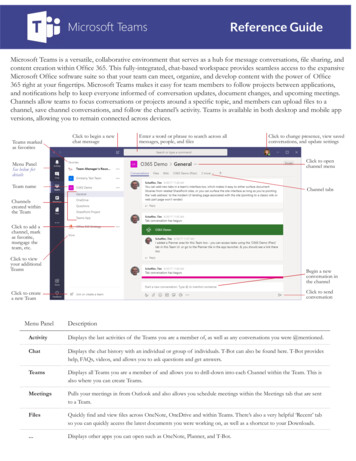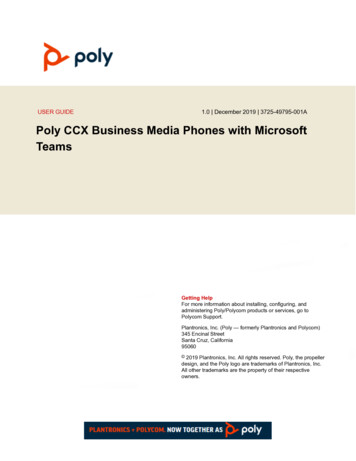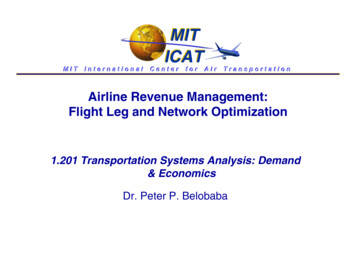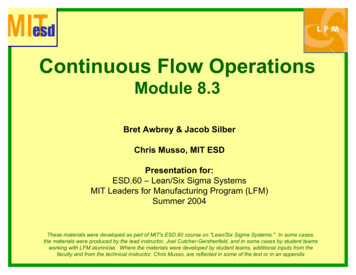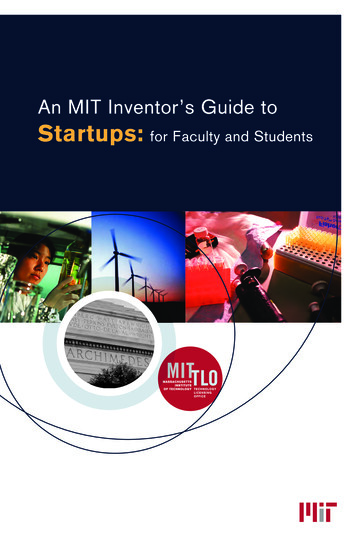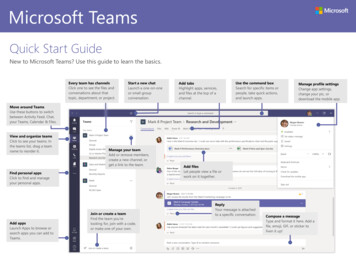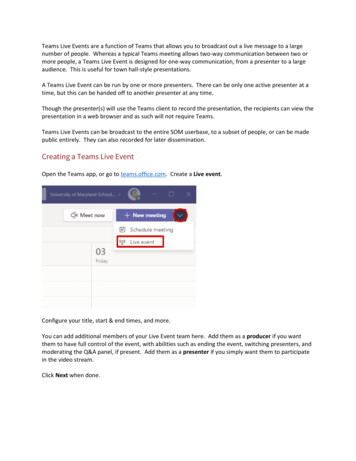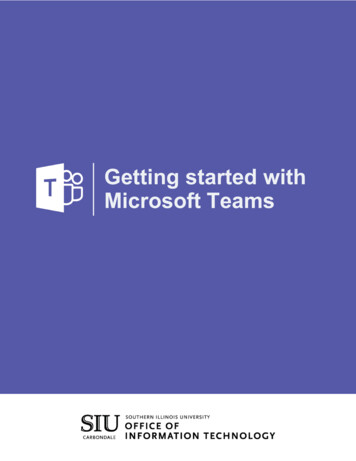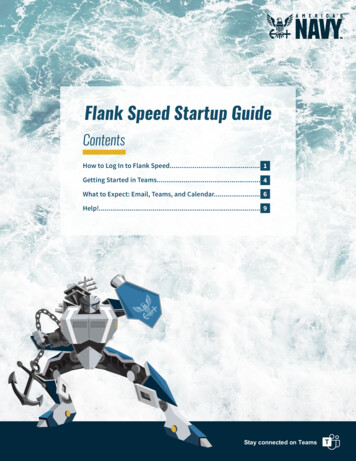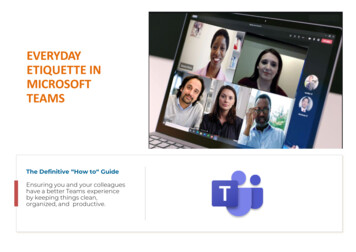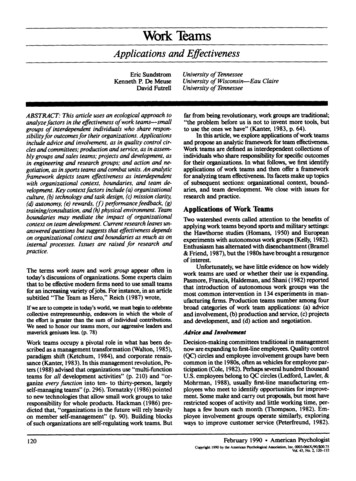
Transcription
Work TeamsApplications and EffectivenessEric SundstromKenneth E De MeuseDavid FutrellIIIII I II IIIillII I Illl IllII Illlilllllllllllillil IIll Illlll Illil IlllllllllllilliiiIlllillllllllABSTRACT." This article uses an ecological approach toanalyze factors in the effectiveness of work teams--smallgroups of interdependent individuals who share responsibility for outcomes for their organizations. Applicationsinclude advice and involvement, as in quality control circles and committees; production and service, as in assembly groups and sales teams; projects and development, asin engineering and research groups; and action and negotiation, as in sports teams and combat units. An analyticframework depicts team effectiveness as interdependentwith organizational context, boundaries, and team development. Key context factors include (a) organizationalculture, (b) technology and task design, (c) mission clarity,(d) autonomy, (e) rewards, ( f ) performance feedback, (g)training/consultation, and (h) physical environment. Teamboundaries may mediate the impact of organizationalcontext on team development. Current research leaves unanswered questions but suggests that effectiveness dependson organizational context and boundaries as much as oninternal processes. Issues are raised for research andpractice.The terms work team and work group appear often intoday's discussions of organizations. Some experts claimthat to be effective modern firms need to use small teamsfor an increasing variety of jobs. For instance, in an articlesubtitled "The Team as Hero," Reich (1987) wrote,If we are to compete in today's world, we must begin to celebratecollective entrepreneurship, endeavors in which the whole ofthe effort is greater than the sum of individual contributions.We need to honor our teams more, our aggressive leaders andmaverick geniuses less. (p. 78)Work teams occupy a pivotal role in what has been described as a management transformation (Walton, 1985),paradigm shift (Ketehum, 1984), and corporate renaissance (Kanter, 1983). In this management revolution, Peters (1988) advised that organizations use "multi-functionteams for all development activities" (p. 210) and "organize every function into ten- to thirty-person, largelyself-managing teams" (p. 296). Tornatzky (1986) pointedto new technologies that allow small work groups to takeresponsibility for whole products. Hackman (1986) predicted that, "organizations in the future will rely heavilyon member self-management" (p. 90). Building blocksof such organizations are self-regulating work teams. But120University of TennesseeUniversity of Wisconsin--Eau ClaireUniversity of Tennesseefar from being revolutionary, work groups are traditional;"the problem before us is not to invent more tools, butto use the ones we have" (Kanter, 1983, p. 64).In this article, we explore applications of work teamsand propose an analytic framework for team effectiveness.Work teams are defined as interdependent collections ofindividuals who share responsibility for specific outcomesfor their organizations. In what follows, we first identifyapplications of work teams and then offer a frameworkfor analyzing team effectiveness. Its facets make up topicsof subsequent sections: organizational context, boundaries, and team development. We close with issues forresearch and practice.Applicationsof WorkTeamsTwo watershed events called attention to the benefits ofapplyingwork teams beyond sportsand mih'tarysettings:the Hawthorne studies(Homans, 1950) and Europeanexperiments with autonomous work groups (Kelly,1982).Enthusiasm has alternated with disenchantment (Bramel& Friend, 1987), but the 1980s have brought a resurgenceof interest.Unfortunately, we have little evidence on how widelywork teams are used or whether their use is expanding.Pasmore, Francis, Haldeman, and Shani (1982) reportedthat introduction of autonomous work groups was themost common intervention in 134 experiments in manufacturing firms. Production teams number among fourbroad categories of work team applications: (a) adviceand involvement, (b) production and service, (c) projectsand development, and (d) action and negotiation.Advice and InvolvementDecision-making committees traditional in managementnow are expanding to first-line employees. Quality control(QC) circles and employee involvement groups have beencommon in the 1980s, often as vehicles for employee participation (Cole, 1982). Perhaps several hundred thousandU.S. employees belong to QC circles (Ledford, Lawler, &Mohrman, 1988), usually first-line manufacturing employees who meet to identify opportunities for improvement. Some make and carry out proposals, but most haverestricted scopes of activity and little working time, perhaps a few hours each month (Thompson, 1982). Employee involvement groups operate similarly, exploringways to improve customer service (Peterfreund, 1982).February 1990 American PsychologistCopyright 1990 by the American Psyc2aologicalA mciafion, Inc. 0003-066X/90/ 00.75Vol. 45, No. 2, 120-133
QC circles and employee involvement groups at timesmay have been implemented poorly (Shea, 1986), butthey have been used extensively in some companies(Banas, 1988).cations can perhaps best be addressed through an analyticframework.Production and ServiceFigure 1 depicts work team effectiveness as dynamicallyinterrelated with organizational context, boundaries, andteam development. It incorporates an ecological perspective (Sundstrom & Altman, 1989) and the premise thatwork teams can best be understood in relation to externalsurroundings and internal processes. The main facets-organizational context, boundaries, and team developmentmreflect current research, theory, and applied literature on work teams.Teams use technology to generate products or services,as in assembly, maintenance, construction, mining, commercial airlines, sales, and others. These usually consistof first-line employees working together full-time, sometimes over protracted periods, with freedom to decidetheir division of labor. For example, at Volvo in Kalmar,Sweden, teams of 15 to 20 employees assemble and installcomponents in an unfinished automobile chassis conveyed by motorized carriers (Katz & Kahn, 1978). Theyelect their own leaders and divide their tasks, but haveoutput quotas. Such teams have been called autonomous(Cummings, 1978), self-managing (Hackman, 1986), orself-regulating (Pearce & Ravlin, 1987) and have beenused in factories at Sherwin-Williams (Poza & Markus,1980), General Foods (Walton, 1977), and Saab (Katz &Kahn, 1978).Projects and DevelopmentGroups of white-collar professionals such as researchers,engineers, designers, and programmers often collaborateon assigned or original projects. Their cycles of work maybe longer than in production and service, and outputsmay be complex and unique. They may have a mandateof innovation more than implementation, broad autonomy, and an extended team life span. An example is ateam of engineers, programmers, and other specialistswho design, program, and test prototype computers(Kidder, 1981). However, their performance may be difficult to assess because the value of their one-of-a-kindoutputs, like studies and patents, may only be apparentlong after the work is finished.Action and NegotiationSports teams, military combat units, flight crews, surgeryteams, musical groups, and others are highly skilled specialist teams cooperating in brief performance events thatrequire improvisation in unpredictable circumstances.They often have elaborate, specialized roles for members.Their missions usually call for outcomes such as negotiating a contract or winning a competition, as in militaryunits (Dyer, 1984) or in executing a safe flight, as in flightcrews (Foushee, 1984).Other applications do not easily fit the types mentioned so far. Examples include some management teams(Bushe, 1987), transition teams for corporate mergers,and start-up teams. However, differences among appliWe are gratefulto IrwinAltman,Wart mBobrow,MaryJane ySmolek,PhilipStone,and an anony m o u s reviewerfor helpfulcommentson earlie draftsof this article.Correspondenceshouldhe addressedto Eric Sundstrom,Department of Psychology,Universityof Tennessee,Knoxville,TN 37916.February 1990 American PsychologistFramework for AnalysisOrganizational ContextRelevant features of the organization external to the workteam, such as reward systems and training resources,comprise its context. Since the late 1970s, the externalfactors seen as relevant to group operation have grownfrom a few selected "inputs" to a long list of factors discovered in practice (Ketchum, 1984) and research (Pasmore et al., 1982). Models of work groups now incorporate many aspects of organizational context (Cummings, 1981; Gladstein, 1984; Hackman, 1987; Kolodny& Kiggnndu, 1980; Pearce & Ravlin, 1987; Shea &Guzzo, 1987a, 1987b). Such factors can augment teameffectiveness by providing resources needed for performance and continued viability as a work unit.BoundariesAn ecological view depicts boundaries as both separatingand linking work teams within their organizations (A1defter, 1987; Friedlander, 1987). Yet group boundariesare difficult to describe concisely, because they subsumeso many aspects of the relationship of group and organization. By boundaries we mean features that (a) differentiate a work unit from others (Cherns, 1976); (b) posereal or symbolic barriers to access or transfer of informarion, goods, or people (Katz & Kahn, 1978); or (c)serve as points of external exchange with other teams,customers, peers, competitors, or other entities (Friedlander, 1987).Boundaries at least partly define how a group needsto operate within its context to be effective. If the boundary becomes too open or indistinct, the team risks becoming overwhelmed and losing its identity. If its boundary is too exclusive, the team might become isolated andlose touch with suppliers, managers, peers, or customers(Alderfer, 1987).Team DevelopmentThis facet reflects the premise that over time, teamschange and develop new ways of operating as they adaptto their contexts. Some features of team development,such as norms and roles, can be seen as structural. Yetit is difficult to identify aspects of groups stable enoughto be called structure. We prefer to err by depicting groupsas too dynamic rather than too static. Temporal patternsi n group processes may be tied to effectiveness during121
even brief work sessions (Sundstrom, Bobrow, Fulton,Blair, & Mcaane, 1988). So we use the term team development to include what has been called group structureas well as interpersonal processes.Team EffectivenessFigure 1 shows effectiveness as consisting of performanceand viability. This two-part definition agrees with someearlier approaches, but is more inclusive than those basedonly on output. Shea and Guzzo (1987b) defined groupeffectiveness as "production of designated products orservices per specification" (p. 329). This overlooks thepossibility that a team can "burn itself up" through unresolved conflict or divisive interaction, leaving membersunwilling to continue working together (Hackman &Oldham, 1980, p. 169). We favor a broad definition thataccounts for members' satisfaction and the group's futureprospects as a work unit by incorporating team viability.At a minimum, this entails members" satisfaction, participation, and willingness to continue working together.A more demanding definition might add cohesion, intermember coordination, mature communication andproblem-solving, and clear norms and rolesmall traditionally identified with team maturity. Performancemeans acceptability of output to customers within oroutside the organization who receive team products, services, information, decisions, or performance events (suchas presentations or competitions).Effectiveness is defined globally to apply to a varietyof work teams, consistent with current thinking (Good122man, Ravlin, & Argote, 1986). However, Goodman (1986)argued for fine-grained criteria of effectiveness such as"quality, quantity, downtime, satisfaction, group stabilityover time" (p. 145). Perhaps global and fine-grained approaches can be merged by measuring specific, local criteria and combining them into general indexes for crossteam comparisons, as in the method pioneered by Pritchard, Jones, Roth, Stuebing, and Ekeberg (1988).InterrelationshipsThe framework is deliberately vague about causal andtemporal dynamics, reflecting the premise that team effectiveness is more a process than an end-state. We departfrom MeGrath's (1964) "'input-process-output" approach(e.g., Gladstein, 1984), which now is even questioned byformer proponents. For instance, Hackman (1987) suggested that groups evaluate their collective performanceas they work, and evaluations affect group processes,which influence subsequent performance. This can yield"self-reinforcing spirals of increasing effectiveness" afterinitial success--perhaps a "synergy bonus" (Hall & Watson, 1971). However, negatively reinforcing spirals of decreasing effectiveness can also create "'process losses"(Steiner, 1972).Adjacent facets of the framework are linked by circular symbols intended to show reciprocal interdependence (Thompson, 1967). For instance, one indicates thatboundaries influence effectiveness, which alters theboundaries, which further influence effectiveness. Ambiguity about temporal dynamics begs the question ofFebruary 1990 American Psychologist
developmental processes in work teams, which we addressafter discussing organizational context and boundaries inrelation to team effectiveness.Organizational Context and Work TeamEffectivenessFigure 1 lists eight aspects of organizational context distilled from several sources, including Cummings andMolloy's (1977) analysis of 16 experiments on autonomous work-groups. Present in more than half of the studies with favorable outcomes were six "action levers": autonomy; technical-physical features such as new equipment or facilities; task variety; information or feedback;pay or rewards; interpersonal interventions. Present inthree or more successful experiments were: training;work-unit support, such as maintenance or technical help;and altered organizational structure as in widened spanof supervisor control or fewer levels of authority. Otherpotentially important context features are mission clarity(Hardaker & Ward, 1987) and organizational culture(Cummings, 1981).Organizational CultureCulture in an organization refers to collective values andnorms (Rousseau & Cooke, 1988). Those that favor innovation (Cummings, 1981) or incorporate shared expectations of success (Shea & Guzzo, 1987a) may especially foster team effectiveness. For instance, Peters andWaterman's (1982) "'excellent" companies valued suchthings as superior quality and service, attention to detail,and support of innovation. Firms that report success inapplying work teams have had similar cultures, oftenguided by philosophies of top managers (Galagan, 1986;Poza & Markus, 1980; Walton, 1977). But culture maybe more a property of work units than a pervasive featureof whole organizations (James, James, & Ashe, in press).Organizational culture probably figures most prominently in the effectiveness of work teams least clearlydefined as work units. For example, new productionteams may look to the wider culture for values and norms.In organizations moving toward self-management, valuesconsistent with team autonomy may foster self-direction(Hackman, 1986). Failed quality circles may have experienced confusion about their purposes (Shea, 1986) andlooked in vain for guidance from organizational culture.Task Design and TechnologyIf the research literature on small groups agrees on onepoint, it is the importance of the task (McGrath, 1984),a major source of differences among work teams. Forinstance, committees spend large shares of their time inproblem-solving meetings, whereas surgery teams spendmuch of their time together in carefully sequenced operations. Team tasks differ on broad categories ofaetivity,such as generating solutions versus executing action plans(McGrath, 1984); technical versus interpersonal demands(Herold, 1978); difficulty (Shaw, 1981); number of desiredoutcomes and trade-offs among them (Campbell, 1988);intermember communications (Naylor & Dickenson,February 1990 American Psychologist1969); coordination requirements (Nieva, Fleishman, &Reick, 1978); task divisibility (Steiner, 1972); subtask demands (Roby & Lanzetta, 1958); and dependence of teamoutcomes on performance by all members (Steiner, 1972).Task design and social organization depend to a degree on technology--and may even be largely determinedby it. For example, coal mining changed with the adventof mechanized conveyors and coal cutters (Trist, Higgins,Murray, & Pollock, 1963). Earlier methods permittedminers to work independently, but new technology created specialized tasks that required miners to synchronizeefforts in small teams. Some technologies allow teammembers to master all tasks; others carry tasks so complexthat each member can master only one, as in musicalgroups and space shuttle crews. Here technology dictatesa social organization of individual roles.Optimal fit among task, technology, and social organization calls for "logical subdivision of the technicalprocess into operating subunits of reasonable size thatcan become partially independent" (Ketchum, 1984, p.247). Ideally, teams produce whole products (Cummings,1981), and do tasks designed for significance, skill, andvariety (Hackman & Oldham, 1980); responsibility foroutcomes (Hackman, 1986); challenge (Cummings,1981); member interdependence (Shea & Guzzo, 1987b);learning, and recognition (Pasmore et al., 1982). Technology can be crucial, asin mining and harvesting crewswhose output depends on equipment design, maintenance, down-time, and other factors (Goodman, Devadas,& Hughson, 1988; Kolodny & Kiggundu, 1980).For work teams who repeatedly do the same workcycle (which often happens in manufacturing), task difficulty may depend on predictability of inputs (Cummings, 1981) or outcomes (Campbell, 1988). Work teamsfaced with unpredictable inputs or uncertain outcomesmay perform best in contexts that foster decentralizedcommunication (Tushman, 1979) and flexible internalcoordination (Argote, 1982; Susman, 1970).Mission ClarityTeam effectiveness may depend on having a clearly definedmission or purpose within the organization (Shea &Guzzo, 1987b). It may entail expectations regarding output, quality, timing, and pacing--and perhaps expectations for anticipating and designing new procedures asthe task changes (Hackman, 1986). Communication of ateam's mission throughout the organization especiallymay help teams whose work is closely linked to or synchronized with that of other work units (e.g., Galagan,1986; Pearce & Ravlin, 1987).AutonomyCentral to work team design and management, autonomyis usually described by reference to three categories: (a)Semi-autonomous groups are supervisor-led (Cherry,1982); (b) self-regulating or self-managing groups electtheir leaders and control their division of labor (Pearce& Ravlin, 1987); and (c) self-designing teams have au123
thority over their definitions as work units and externalrelations (Hackman, 1987).Team autonomy depends on the role of leader(Hackman & Walton, 1986) and on how authority is distributed. A team can have a manager, administrator,leader, supervisor, facilitator, director, coordinator,spokesperson, or chairperson--or several of these. Division of leadership among manager(s) and members mayvary with team longevity and maturity. Manz and Sims(1987) recommended that managers foster self-management by acting as "un-leaders." Eventually a team maydevelop its own leadership capabilities if given a progressively less prominent leader role (Glickman et al., 1987).Performance FeedbackPractitioners agree that team effectiveness depends on accurate, timely feedback on performance (Ketchum, 1984;Kolodny & Kiggundu, 1980) despite limited research evidence (Dyer, 1984). Koch's (1979) study of sewing machine operator groups found increased product qualitybut decreased satisfaction alter the introduction of specificgoals with systematic feedback. Nadier, Cammann, andMirvis (1980) had mixed success with a feedback systemin retail banks in which performance was not tied to workunit rewards. Pdtchard et al. (1988) used goal-setting andfeedback (with team incentives) to bring about improvedperformance and satisfaction in aviation maintenanceteams.Performance feedback requires dependable measurement systems. These are probably most feasible inteams with repetitive, quantifiable output and short cyclesof work, such as coal mining crews and assembly teams.Feedback may be more difficult in teams with longer cycles of work and/or one-of-a-kind outputs, such as projectand development teams.Rewards and RecognitionTeam performance may hinge on desirable consequencesto individual members contingent on the whole team'sperformance--or outcome interdependence. Outcomescan include public recognition and praise for team successes, team celebrations, or individual rewards such aspreferred work assignments, desirable schedules, ormoney. Shea and Guzzo (1987b) tested the effects of cashperformance incentives on retail sales teams. Contraryto prediction, rewards did not bring increases in teamsales, but members' evaluations of customer service roseand the organization showed higher sales overall. In contrast, Pritchard et al. (1988) did find increased performance (and satisfaction) in aviation maintenance unitsafter introducing a group incentive plan based ontime off.Training and ConsultationTraditional among prescriptions for work team effectiveness are training and consultation on team tasks and interpersonal processes. But apart from a few case studieswe know little about the appropriate content or designof team training programs (Dyer, 1984). Key interpersonal124skills may include "un-leadership" (Manz & Sims, 1987).An approach to technical skills in production groups,often called "cross-training," provides training and incentives for learning new skills in teams whose memberscan rotate jobs (Poza & Markus, 1980).Physical EnvironmentInter-member communication and cohesion may dependon the extent to which informal, face-to-face interactionis fostered by proximity of work-stations and gatheringplaces (Sundstrom, 1986; see also Stone & Luchetti,1985). Territories can reinforce group boundaries (Miller,1959) and foster or inhibit external exchange. When taskscall for external coordination, exchange can be aided byreception and conference rooms. In cases in which groupprocesses are easily disrupted, effectiveness may be aidedby enclosed group working areas. So, physical environments are central to group boundaries (Sundstrom &Airman, 1989).Boundaries and Work Team EffectivenessThe framework in Figure 1 suggests that group boundariesmediate between organizational context and team development and are tied to effectiveness. By defining the relation of a work team and its organization, boundariesalso help define what constitutes effectiveness for the teamin its particular context (Sundstrom & Airman, 1989).Besides doing its task, a work team has to satisfy requirements of the larger system and maintain enough independence to perform specialized functions (Berrien,1983). So one key aspect of the group-organizationboundary is integration into the larger system throughcoordination and synchronization with suppliers, managers, peers, and customers. When a team's mission requires a high degree of external integration or linkage,effectiveness depends on the pace and timing of exchangeswith other work units, as in a production team that getsmaterials from the preceding team and provides the nextoperation with materials for its work. When one teamfalls behind, the whole system suffers (Kolodny & Dresner,1986). In cases in which team performance depends lesson timing and synchronization with counterpart workunits, effectiveness may be more a function of internalgroup processes.A second key aspect of group-organization boundaries is differentiation (Lawrence & Lorsch, 1969), or thedegree of specialization, independence, and autonomy ofa work team in relation to other work units. Differentiation of a work team in an organization can occur whenthe mission requires special expertise or facilities, or isolation from contamination and interference, as in a surgery team. Team effectiveness can hinge on the ability toisolate certain activities from outside interference, suchas sensitive operations, problem-solving meetings, orpractice sessions. A team can be differentiated from otherwork units through exclusive membership, extendedworking time or team life span, or exclusive access tophysical facilities such as surgery suites or product testinglaboratories.February 1990 American Psychologist
Table 1Applications of Work Teams: Differentiation, External Integration, Work-Cycles, and OutputsApplicationsand examplesWork-teamdifferentiationExtq rnalIntegrationWork view panels, beardsQuality control circlesEmployee involvementgroupsAdvisory councilsLow differentiation:Inclusive orrepresentativemembership; Oftenshort group lifespan and/or limitedworking time.Low integration:Often few demands forsynchronization withother work-units;extemal exchange canbe minimal; work-cyclemay not be repeated.Work-cycles canbe brief orlong; one cyclecan be teamlife endationsProductionleerviceAssembly teamsManufacturing crewsMining teamsFlight attendant crewsData processing groupsMaintenance crewsLow differentiation:Variable membershiprequirements;sometimes highturnover; variableteam life span;often specialfacilities,High integration:Externally paced workusually synchronizedwith suppliers andcustomers inside andoutside theorganization,Work-cyclestypicallyrepeated orcontinuousprocess; cyclesoften brieferthan team lifespan.Food, chemicalsComponentsAssembliesRetail salesCustomer serviceEquipment repairsProject/developmentResearch groupsPlanning teamsArchitect teamsEngineering teamsDevelopment teemsTask forcesHigh differentiation:Members usuallyexpert specialists;task may requirespecializedfacilities;Sometimesextended team lifespan.Low integration:Often internally pacedproject with deadline;little synchronizationinside organization;task can require muchexternalcommunication.Work-cyclestypically differfor each newproject; onecycle can beteam life span.Plans, s, findingsAction/negotiationSports teamsEntertainment groupsExpeditionsNegotiating teamsSurgery teamsCockpit crewsHigh differentiation:Exclusivemembership ofexpert specialists;specialized trainingand performancefacilities;Sometemesextended team lifespan.High integration:Performance eventsclosely synchronizedwith counterparts &support units insidethe organization,Brief performanceevents, oftenrepeated undernew conditions,requiringextendedtraining and/orpreparation.Combat caloperationsCompetitionsDemands for external integration and differentiationinherent in the relationship of a team and the surroundingorganization can be seen as partly specifying what constitutes team effectiveness. A taxonomy by Sundstromand Altman (1989) uses integration and differentiationto identify four types of work groups whose boundariescreate different demands for effectiveness, shown in Table1. The types correspond with the four applications ofwork teams mentioned earlier: (a) advice and involvementgroups; (b) production and service teams; (c) project anddevelopment teams; and (d) action and negotiation teams.An example of a team low on both external integrationand differentiationman advice and involvement group-is a quality control circle. Differentiation is minimal inthat membership is often broadly representative, workingtime is limited, and the group may have only a temporarymeeting room. External integration is also minimal:Within broad limits a QC circle can proceed at its ownFebruary 1990 American Psychologistpace with few requirements for synchronization withother work units. Its work may call for external communication, but the task imposes few constraints on timing or turn-around. In contrast, the organizational contextof action and negotiation teams often demands both external differentiation and integration, which dictate conditions for team effectiveness. For example, a cockpit crewconsists of qualified experts who work in specialized, limited-access facilities (their cockpits), and performancedepends on their ability to work without distraction orinterference. They carry out complex performance events(flights) that call for activities closely synchronized withthose of other work units (ground crew, cabin crew, control tower, and other cockpit crews). High levels of externaldifferentiation and integration may make such teamssensitive to particular features of organizational context,such as training and technology, which in turn mightenter into team development.125
External Integration: Coordination With Suppliers,Managers, Peers, Staff, and CustomersExternal integration represents the way a team fits intothe larger organization, or the external demands inherentin its boundary. A team's work can be seen as a processof receiving materials or information from suppliers;transforming or adding value in cooperation with managers, peers, and staff; and delivering output to team customers. (A team's customer can be inside the organization,like a packaging and shipping department in a factory.)The need for coordination with externa
work teams can best be understood in relation to external surroundings and internal processes. The main facets-- organizational context, boundaries, and team develop- mentmreflect current research, theory, and applied lit- eratu
